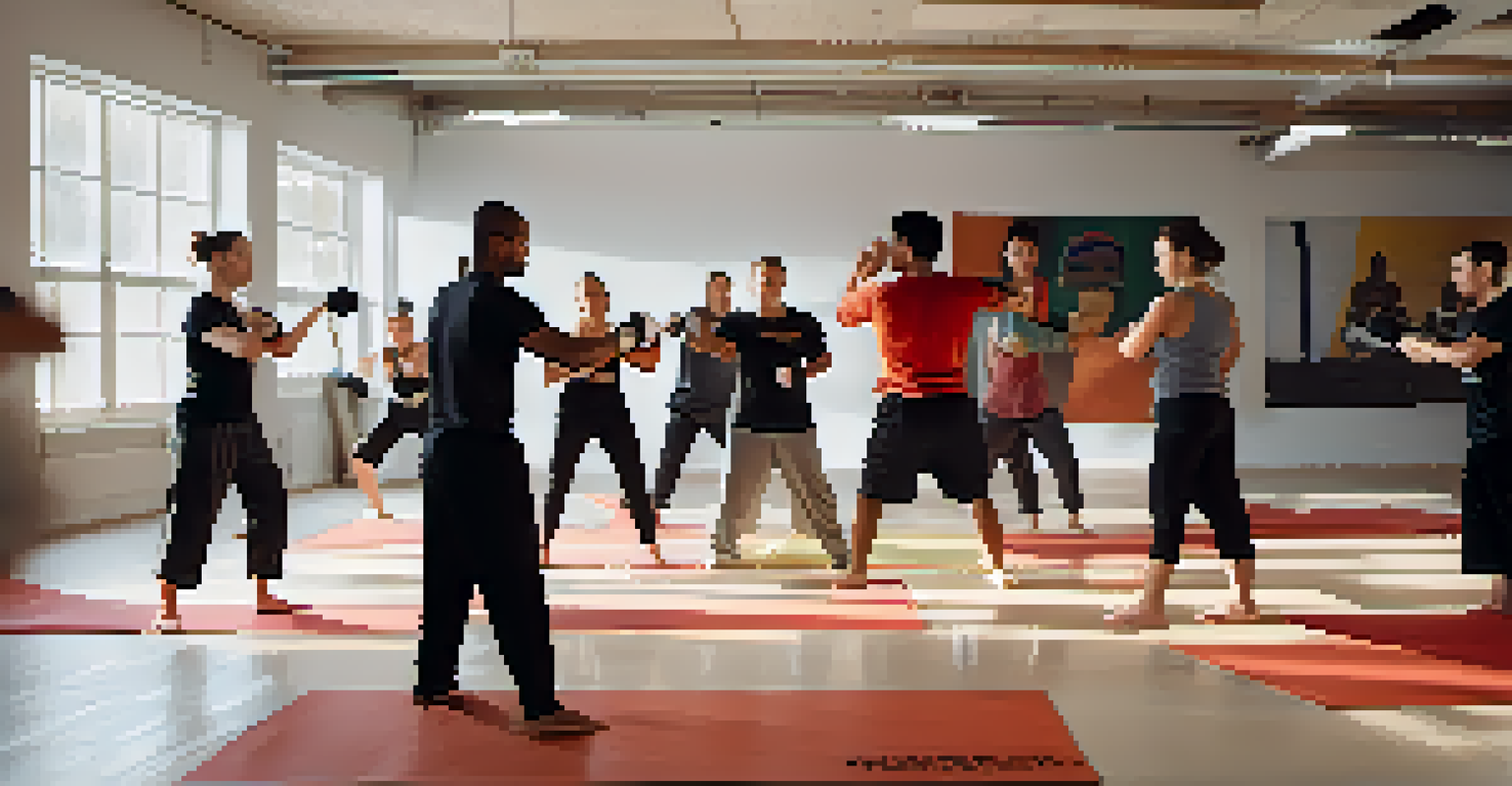Essential Self Defense Techniques for Urban Environments

Understanding Urban Self-Defense Basics
Self-defense in urban environments requires a unique mindset. Unlike secluded areas, the hustle and bustle of city life can present unexpected threats. Being aware of your surroundings is the first line of defense; it's about recognizing potential dangers before they escalate.
The best defense is a good offense.
In an urban setting, threats can come from various angles: crowds, alleyways, or even public transport. Knowing how to respond quickly and effectively can make a crucial difference. This isn't just about physical techniques; mental preparedness is equally important.
One of the key principles is to avoid confrontation whenever possible. The goal is to escape safely, not to engage in combat. However, if you find yourself in a threatening situation, having a plan can empower you to act decisively.
Situational Awareness: Your First Defense
Situational awareness is akin to having a sixth sense. It involves being conscious of your environment and understanding the dynamics around you. By honing this skill, you can detect unusual behavior or potential threats before they become serious.

For example, if someone seems to be following you, stay alert and consider altering your route. This simple action can disrupt any ill intentions. Additionally, using your instincts can often guide you to safety—if something feels off, it probably is.
Situational Awareness is Key
Being aware of your surroundings can help you identify potential threats before they escalate.
Practicing situational awareness means being attentive to body language and other non-verbal cues. Just as a driver scans the road for hazards, you should scan your surroundings for anything that seems out of place. This skill can be cultivated over time, enhancing your overall safety.
Verbal De-Escalation Techniques
When faced with a potential confrontation, words can be your most powerful weapon. Verbal de-escalation is about communicating calmly and effectively to diffuse a tense situation. This technique can often prevent physical altercations altogether.
In any conflict, the best weapon is a calm mind.
For instance, using a calm tone and open body language can signal that you're not a threat. Phrases like 'I don't want any trouble' can help to ease tension. The key is to keep your voice steady and avoid any confrontational language.
Remember, the goal is not to confront aggressively but to create a dialogue. Often, showing empathy and understanding can turn a potentially dangerous situation into a peaceful exit for both parties. Practice this skill in everyday interactions to build your confidence.
Basic Physical Self-Defense Moves
While avoiding confrontation is ideal, knowing basic self-defense moves is essential. Techniques like the palm strike or knee to the groin can be effective for quick escapes. These moves require minimal training but can create the necessary space to get away.
For example, if someone grabs your wrist, a swift twist followed by a strike to the attacker’s vulnerable areas can help you break free. Practicing these moves with a friend can build muscle memory, making you feel more prepared in real situations.
Use Words to De-Escalate Conflicts
Effective communication can often diffuse tense situations, preventing physical confrontations.
Moreover, it’s important to remember that the aim is to escape rather than to fight. Every second counts when you’re in danger, so being able to quickly execute these techniques can significantly increase your chances of getting to safety.
Using Everyday Items as Tools
In urban environments, everyday items can serve as effective self-defense tools. Things like keys, pens, or even a water bottle can be used to protect yourself when necessary. The key is to think creatively about how you can leverage what you have on hand.
For instance, holding your keys between your fingers can enhance your fist's striking power. Similarly, if you’re carrying a pen, it can be used for quick jabs if someone gets too close. The familiarity of these items can also make you feel more comfortable using them in a tense situation.
However, it’s important to know when to use these items. They should only be employed if absolutely necessary, as your primary goal should always be to escape safely. Understanding how to utilize these tools can add an extra layer of confidence in your self-defense strategy.
Understanding Legal and Ethical Considerations
When discussing self-defense, it's crucial to understand the legal implications. Laws vary significantly by location, so knowing your rights and responsibilities can protect you from further trouble after an incident. Self-defense should always be a last resort.
In many jurisdictions, the use of force must be proportional to the threat. For example, using deadly force against a non-lethal threat can lead to serious legal consequences. Familiarizing yourself with local laws is essential for informed decision-making.
Self-Defense Training Empowers You
Taking self-defense classes enhances your skills and confidence, preparing you for real-life scenarios.
Additionally, ethical considerations play a role in self-defense. Always prioritize de-escalation and avoidance before resorting to physical action. Being aware of these nuances can help you navigate complex situations with confidence and clarity.
The Importance of Self-Defense Training
Taking a self-defense class can be one of the best investments in your safety. These classes provide hands-on experience and teach valuable techniques that can be life-saving. Moreover, the sense of community and support found in these classes can boost your confidence.
Training not only equips you with physical skills but also heightens your awareness and mental preparedness. Regular practice helps reinforce these skills, making them instinctive in times of crisis. It’s about building a toolbox of strategies you can rely on.

Furthermore, many classes offer insights into psychological aspects of self-defense, such as managing fear and anxiety in threatening situations. This holistic approach to self-defense can empower you to handle various scenarios with poise and confidence.